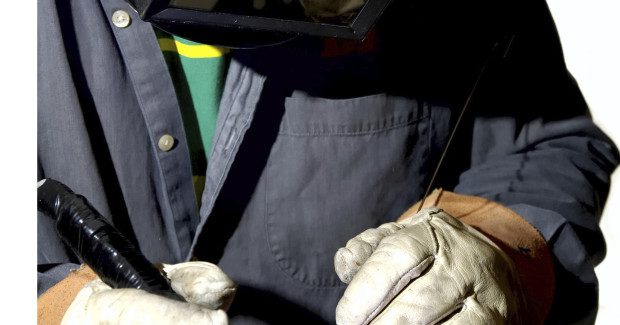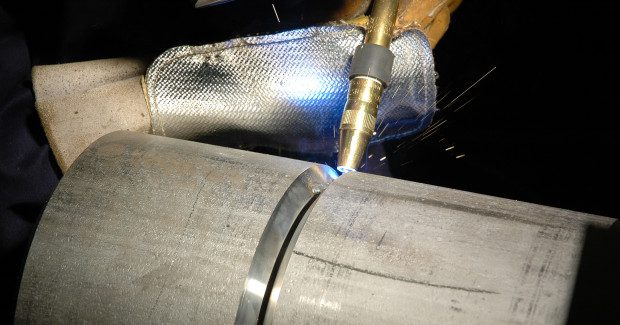Filler Metal: The Key to Welding Austenitic Stainless Steel Tube and Pipe
Welding austenitic stainless steel does present some challenges compared to welding ordinary steel piping. Special attention must be paid to the amount of heat input during welding, and beforehand when selecting filler metals. Here is a brief overview of the sizes and types of filler metals used with each welding process, as well as their pros and cons.
Posted: December 16, 2013
Due to its corrosion resistance and good mechanical properties — particularly at low temperatures — austenitic stainless steel piping is commonly used in several industries: pharmaceutical, energy, and chemical refining to name a few. It is also widely used in food processing plants where its corrosion resistance is needed to meet the industry’s safety and sanitary standards.
However, welding austenitic stainless steel does present some challenges compared to welding ordinary steel piping. Special attention must be paid to the amount of heat input during welding, and beforehand when selecting filler metals.
THE ROLE OF FILLER METAL
The biggest risk when joining austenitic stainless steel is the threat of hot cracking — micro-cracks that occur as the weld freezes. Hot cracking can occur when the weld metal chemistry doesn’t match the base metal chemistry or if dirt, grease, or other foreign material contaminates the weld. The right filler metal can help prevent cracking and also ensure that the weld joint maintains the same corrosion resistance as the base material.
Filler metals must match the base material according to their chemical and mechanical properties. The intended service dictates what grade of austenitic stainless steel will be used for a given application, which in turn dictates what filler metal to use. Tables outlining base materials and filler metal matches are readily available from filler metal manufacturers or on the Internet.
Jim Cuhel of Miller Electric discusses five key steps when considering welding stainless steel pipe without a backing gas. For more on welding stainless steel tube and pipe, click here.
Most grades of stainless steel filler metals are available in a variety of sizes and forms to suit each welding process. Here’s a brief overview of the sizes and types of filler metals used with each welding process, as well as their pros and cons.
GAS TUNGSTEN ARC WELDING (GTAW)
GTAW is the most prevalent process used for welding thin-walled stainless pipe or tube, namely because it produces high quality results and does not need a slag cover to shield the molten weld pool. Welding is done using 36 in long cut lengths rods, typically ranging from 1/16 in to 1/8 in diameter.
As a downfall, travel speed is slow while using GTAW, lessening productivity. The process also requires back-purging the weld joint to shield the weld from the atmosphere, which increases the time and cost for every weld.
SHIELDED METAL ARC WELDING (SMAW)
SMAW (or stick welding) is a frequent choice for field welding of stainless steel piping; it requires relatively simple equipment and no shielding gas. SMAW also has a long history of use and is familiar to virtually all welders. Stick electrodes are typically available in diameters ranging from 3/32 in to 5/32 in that are 12 in long. Their size and performance make them well suited to welding in cramped spaces where more bulky welding equipment won’t fit.
That said, the overall efficiency of stick welding is still low due to frequent electrode changeover and the waste of discarding unused electrode portions.
GAS METAL ARC WELDING (GMAW)
For welding thicker wall (1/2 in or more) stainless steel pipe, GMAW using a solid wire is becoming a common choice due to its high productivity. There are fewer stops and starts in each joint, which also reduces the opportunity for defects and helps improve overall quality. Solid wire is readily available for common grades of stainless steels. The shielding gases required will vary based on the stainless steel grade and the specifics weld parameters.
GMAW can be used to weld pipe joints in a shop environment, where the pipe is easy to rotate, keeping the weld in the flat position. GMAW can also be performed out of position on fixed pipe joints using pulsed or advanced short circuit variants of the process.
Stainless steel solid wires are available in several diameters, commonly 0.035 in or 0.045 in and typically in 2 lb, 10 lb and 30 lb spools. They are readily available for common grades of stainless steels, compared to more exotic materials or applications with unusual chemistry requirements, which can be difficult to source and have longer lead times.
METAL-CORED ARC WELDING (MCAW)
Metal-cored filler metals are becoming a popular alternative to solid wires for welding thicker walled stainless steel piping. They can provide faster travel speeds and greater deposition rates. Metal-cored wires use the same equipment as solid wires, as well as similar shielding gases.
Cost for metal-cored wires can be slightly higher than the equivalent solid wire products; however, these wires can be produced with custom chemistries in a fraction of the time it would take to source an equivalent solid wire product. Metal-cored wires can also be produced in large or small quantities to suit the customer’s specific needs. Stainless steel metal-cored filler metals are typically available in 0.045 in and 1/16 in diameters and packaging are similar to those found for solid wire.
FLUX-CORED WIRES (FCAW)
Gas-shielded flux-cored wires are an excellent option for achieving high deposition rates when performing welding on pipes in a fixed position. The slag covering the weld deposit holds the molten weld puddle in place until it freezes and also helps to shield the weld metal until it’s cool enough to be exposed to the atmosphere. FCAW relies on standard CV welding power supplies and commonly available shielding gases. Most wires require either 75/25 argon/CO2 blend, but some call for 100 percent CO2 shielding gas.
Check with the manufacturer for the proper gas for each product. Product sizes and packaging are similar to those used with other wire products.
FCAW filler metals typically produce more smoke and spatter than other filler metals and processes. The slag coating must also be cleaned from each weld pass prior to depositing the next weld bead. These factors may make FCAW unsuitable for use in some environments or in certain applications.
For questions about stainless steel projects, consult with a trusted welding distributor or filler metal manufacturer. They offer assistance in selecting the optimal process and filler metal.






